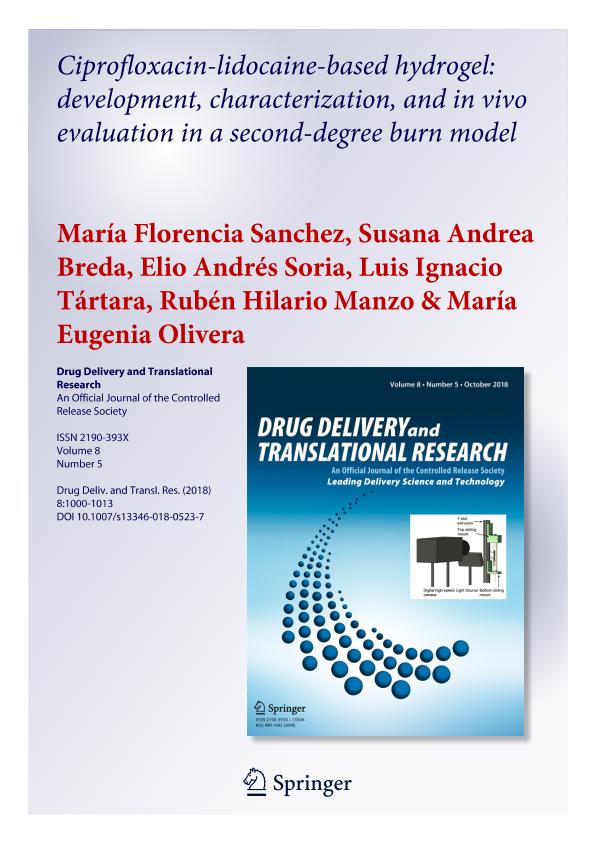Artículo
Ciprofloxacin-lidocaine-based hydrogel: Development, characterization and in vivo evaluation in a second-degree burn model
Sanchez, Maria Florencia ; Breda, Susana Andrea
; Breda, Susana Andrea ; Soria, Elio Andres
; Soria, Elio Andres ; Tartara, Luis Ignacio
; Tartara, Luis Ignacio ; Manzo, Ruben Hilario
; Manzo, Ruben Hilario ; Olivera, Maria Eugenia
; Olivera, Maria Eugenia
 ; Breda, Susana Andrea
; Breda, Susana Andrea ; Soria, Elio Andres
; Soria, Elio Andres ; Tartara, Luis Ignacio
; Tartara, Luis Ignacio ; Manzo, Ruben Hilario
; Manzo, Ruben Hilario ; Olivera, Maria Eugenia
; Olivera, Maria Eugenia
Fecha de publicación:
13/10/2018
Editorial:
Springer Verlag
Revista:
Drug Delivery and Translational Research
ISSN:
2190-393X
e-ISSN:
2190-3948
Idioma:
Inglés
Tipo de recurso:
Artículo publicado
Clasificación temática:
Resumen
The purpose of this work was to develop an effective carbomer hydrogel to be used to treat second-degree burns that combined ciprofloxacin and lidocaine (CbCipLid hydrogel). Its antibiotic and anesthetic efficacy and the physical and chemical properties of the CbCipLid hydrogel (release rate and kinetics, rheology, appearance, and drug content) were evaluated both before and after a sterilization cycle and also after 6 months of storage. For the in vivo studies, second-degree burns were developed in a rat model. Animals were divided into three groups: CbCipLid hydrogel, silver sulfadiazine cream (reference), and carbomer hydrogel (as control). The treatments were applied daily for 21 days, and the healing was monitored by macroscopic observation and histologic evaluation. The anesthetic effect was evaluated through the corneal touch threshold in a rabbit eye model. The CbCipLid hydrogel obtained is transparent and allows the loading of ciprofloxacin above its solubility at a neutral pH, with a rheology which is convenient for topical administration. Its physical and chemical properties remained unchanged after sterilization and for at least six additional months. Both ciprofloxacin and lidocaine are reversibly released from the CbCipLid hydrogel with a kinetics fitting the Higuchi model. The presence of a biologic-like fluid increased the rate of drug delivery through an ionic exchange mechanism. Treatment with the CbCipLid hydrogel decreased the wound-healing period, compared with the reference, and was associated with a greater number of fibroblasts and a faster rate of epithelialization and dermis reconstruction. These differences were assigned to the moist environment provided by the hydrogel and also to the presence of a therapeutic concentration of ciprofloxacin. Moreover, CbCipLid hydrogel provides an immediate anesthetic effect, which is significantly more intense than that of the reference. Based on these results, it is believed that the CbCipLid hydrogel could be a potential candidate in the prophylaxis/treatment of second-degree burns.
Archivos asociados
Licencia
Identificadores
Colecciones
Articulos(INICSA)
Articulos de INSTITUTO DE INVESTIGACIONES EN CIENCIAS DE LA SALUD
Articulos de INSTITUTO DE INVESTIGACIONES EN CIENCIAS DE LA SALUD
Articulos(UNITEFA)
Articulos de UNIDAD DE INVESTIGACION Y DESARROLLO EN TECNOLOGIA FARMACEUTICA
Articulos de UNIDAD DE INVESTIGACION Y DESARROLLO EN TECNOLOGIA FARMACEUTICA
Citación
Sanchez, Maria Florencia; Breda, Susana Andrea; Soria, Elio Andres; Tartara, Luis Ignacio; Manzo, Ruben Hilario; et al.; Ciprofloxacin-lidocaine-based hydrogel: Development, characterization and in vivo evaluation in a second-degree burn model; Springer Verlag; Drug Delivery and Translational Research; 8; 5; 13-10-2018; 1000-1013
Compartir
Altmétricas



